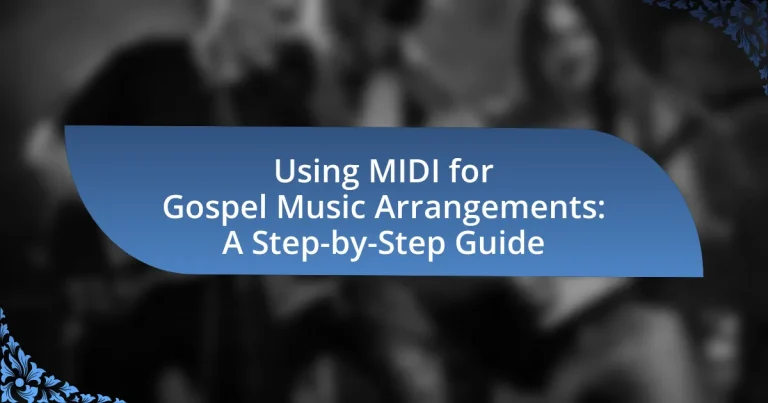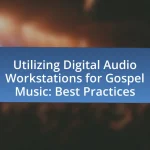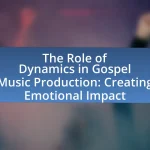The article focuses on the use of MIDI (Musical Instrument Digital Interface) in Gospel music arrangements, detailing its significance in modern music production. It explains how MIDI facilitates the creation, editing, and playback of complex musical compositions, allowing musicians to layer sounds and control dynamics effectively. Key components of MIDI technology, its differences from traditional music notation, and the advantages it offers to Gospel musicians are discussed. Additionally, the article outlines steps for creating Gospel music arrangements using MIDI, essential techniques for effective arrangement, and best practices to maintain authenticity while leveraging digital tools. Troubleshooting common MIDI issues and optimizing performance settings are also covered, providing a comprehensive guide for musicians looking to enhance their Gospel music arrangements with MIDI technology.
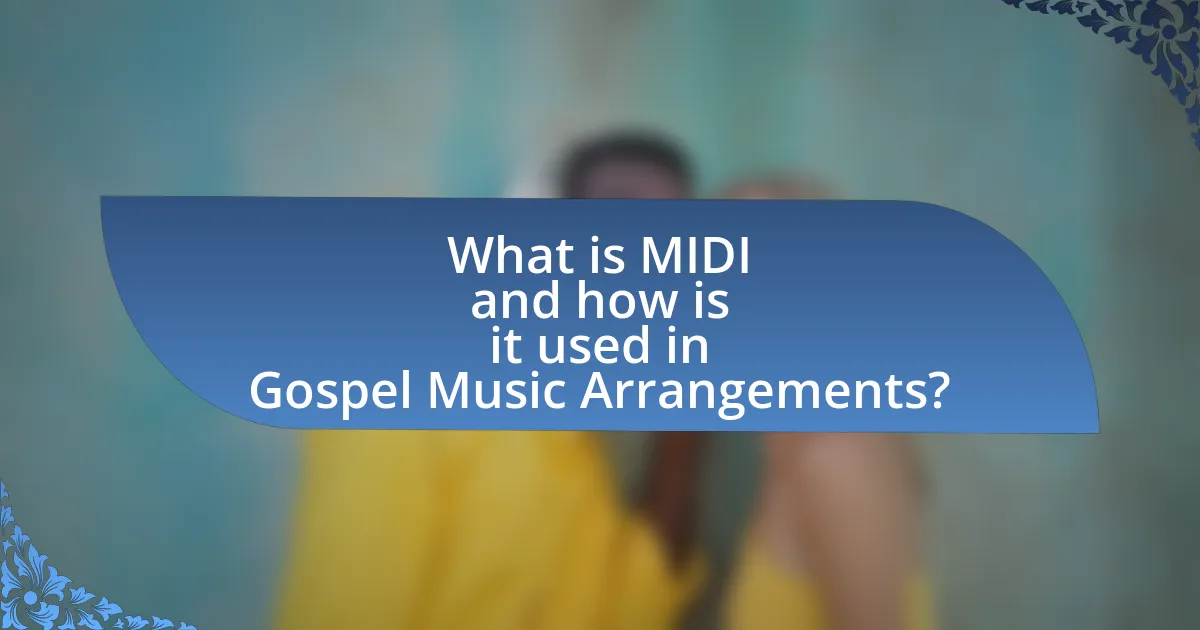
What is MIDI and how is it used in Gospel Music Arrangements?
MIDI, or Musical Instrument Digital Interface, is a technical standard that allows electronic musical instruments, computers, and other devices to communicate and synchronize with each other. In Gospel music arrangements, MIDI is utilized to create, edit, and playback musical compositions, enabling musicians to layer sounds, control dynamics, and arrange complex harmonies efficiently. For instance, MIDI allows for the integration of virtual instruments and sound libraries, which can replicate traditional Gospel sounds like organs and choirs, enhancing the overall arrangement without the need for live musicians. This capability is particularly valuable in modern Gospel music production, where quick adjustments and experimentation are essential for achieving the desired sound.
How does MIDI technology function in music production?
MIDI technology functions in music production by transmitting digital signals that represent musical notes and performance data between devices. This allows musicians and producers to control synthesizers, drum machines, and software instruments, enabling them to create, edit, and arrange music efficiently. MIDI data includes information such as pitch, velocity, and duration, which can be manipulated in digital audio workstations (DAWs) to produce complex compositions. The versatility of MIDI has made it a standard in the music industry since its introduction in the early 1980s, facilitating collaboration and creativity across various genres, including gospel music arrangements.
What are the key components of MIDI technology?
The key components of MIDI technology include MIDI messages, MIDI channels, and MIDI devices. MIDI messages are the data packets that convey information about musical notes, control changes, and other performance parameters. MIDI channels allow for the separation of different instruments or sounds, enabling multiple instruments to be controlled independently over a single connection. MIDI devices, such as keyboards, synthesizers, and computers, serve as the hardware and software interfaces that generate, transmit, and receive MIDI data, facilitating communication between various musical instruments and equipment. These components work together to create a standardized method for electronic music production and performance.
How does MIDI differ from traditional music notation?
MIDI differs from traditional music notation in that MIDI represents musical information digitally, while traditional notation uses symbols on a staff to convey music. MIDI encodes performance data such as pitch, velocity, and duration, allowing for real-time manipulation and playback through electronic instruments, whereas traditional notation requires interpretation by musicians to perform the music as written. This digital format enables features like editing and sequencing, which are not possible with static sheet music.
Why is MIDI important for Gospel music arrangements?
MIDI is important for Gospel music arrangements because it allows for precise control over musical elements, enabling composers and arrangers to create complex arrangements efficiently. The use of MIDI facilitates the integration of various instruments and voices, allowing for real-time adjustments and the ability to layer sounds seamlessly. Additionally, MIDI’s digital format supports easy editing and playback, which is essential for arranging the intricate harmonies and rhythms characteristic of Gospel music. This capability is particularly valuable in collaborative settings, where multiple musicians can contribute to a single arrangement without the limitations of traditional notation.
What advantages does MIDI offer to Gospel musicians?
MIDI offers Gospel musicians enhanced flexibility and creativity in music arrangement. By utilizing MIDI, musicians can easily manipulate musical elements such as pitch, tempo, and instrumentation, allowing for intricate arrangements that can be tailored to specific worship settings. Additionally, MIDI facilitates seamless collaboration among musicians, as it enables the sharing of compositions and arrangements digitally, streamlining the rehearsal process. The ability to integrate various virtual instruments and sound libraries further enriches the musical experience, providing Gospel musicians with a diverse palette of sounds to work with.
How can MIDI enhance the creative process in Gospel music?
MIDI enhances the creative process in Gospel music by providing musicians with versatile tools for composition and arrangement. It allows for the easy manipulation of musical elements such as melody, harmony, and rhythm, enabling artists to experiment with different sounds and arrangements without the need for extensive recording equipment. For instance, MIDI can facilitate the layering of multiple instruments, creating rich textures that are characteristic of Gospel music. Additionally, MIDI’s quantization feature helps in achieving precise timing, which is crucial for maintaining the rhythmic integrity of Gospel performances. This technology also supports the use of virtual instruments, expanding the sonic palette available to Gospel musicians, thus fostering innovation and creativity in their compositions.
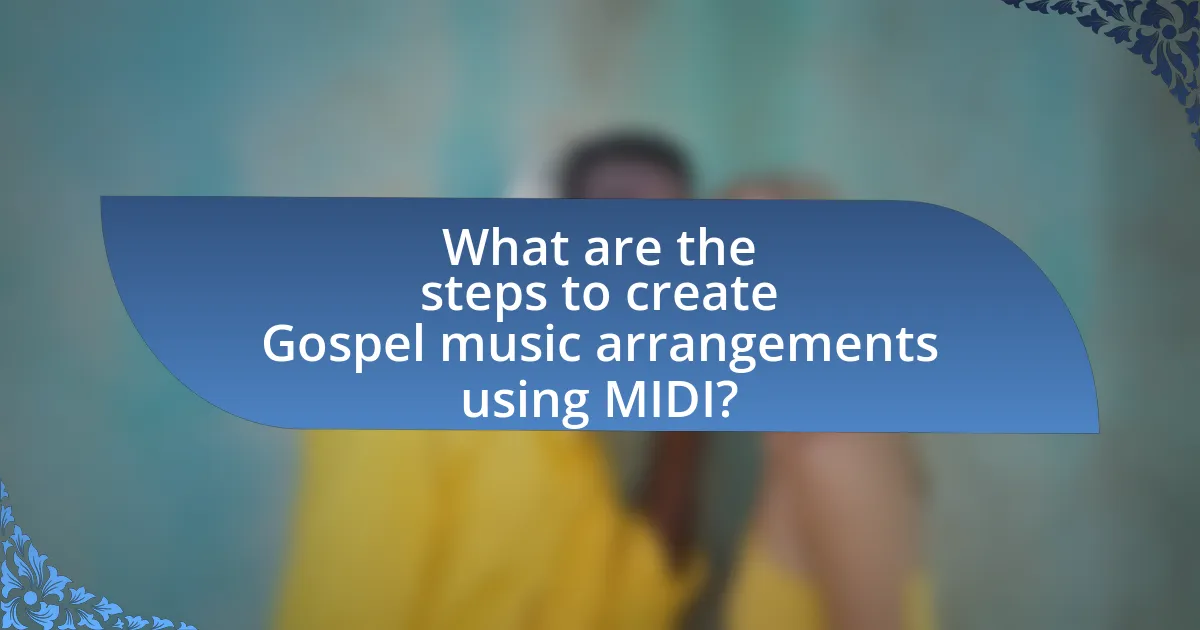
What are the steps to create Gospel music arrangements using MIDI?
To create Gospel music arrangements using MIDI, follow these steps: First, select a Digital Audio Workstation (DAW) that supports MIDI, such as Ableton Live or Logic Pro. Next, create a new project and set the tempo to match the desired feel of the Gospel piece, typically between 70-120 BPM. Then, input the chord progressions using a MIDI keyboard or the DAW’s piano roll, focusing on common Gospel chords like major, minor, and seventh chords.
After establishing the chords, add melody lines by recording or programming them into the MIDI tracks. Incorporate various instruments commonly found in Gospel music, such as piano, organ, and strings, by selecting appropriate MIDI instrument sounds. Layer additional harmonies and vocal parts to enrich the arrangement, ensuring they complement the main melody.
Finally, adjust the dynamics, panning, and effects to enhance the overall sound. Export the final arrangement as a MIDI file or audio track for further use. This process is validated by the widespread use of MIDI in modern music production, allowing for precise control over musical elements and facilitating collaboration among musicians.
How do you set up your MIDI environment for Gospel music?
To set up your MIDI environment for Gospel music, begin by selecting a Digital Audio Workstation (DAW) that supports MIDI, such as Ableton Live or Logic Pro. Next, connect your MIDI controller to your computer via USB, ensuring that the DAW recognizes the device. Configure the MIDI settings in the DAW to assign channels and instruments that reflect Gospel music’s rich harmonic structure, often utilizing pianos, organs, and strings. Finally, load Gospel-specific sound libraries or virtual instruments to enhance the authenticity of your arrangements. This setup allows for seamless integration of MIDI data, facilitating the creation of complex Gospel compositions.
What software and hardware are recommended for MIDI arrangements?
For MIDI arrangements, recommended software includes Ableton Live, Logic Pro X, and FL Studio, while recommended hardware consists of MIDI controllers like the Akai MPK Mini and audio interfaces such as Focusrite Scarlett 2i2. These software options provide robust features for composing and editing MIDI, while the hardware enhances the user experience by allowing for tactile control and high-quality audio input/output. For instance, Ableton Live is widely used for its intuitive interface and powerful MIDI capabilities, making it a favorite among music producers. Similarly, the Akai MPK Mini is favored for its portability and functionality, allowing musicians to create MIDI arrangements efficiently.
How do you configure MIDI settings for optimal performance?
To configure MIDI settings for optimal performance, set the MIDI buffer size to a low value to reduce latency, typically between 128 to 256 samples. This adjustment minimizes the delay between input and output, enhancing responsiveness during live performances. Additionally, ensure that the MIDI clock is synchronized across devices to maintain timing accuracy, which is crucial for cohesive musical arrangements. Using a dedicated MIDI interface can also improve performance by providing better data throughput compared to built-in sound card MIDI ports. These practices are supported by industry standards, which emphasize the importance of low latency and synchronization in professional music production environments.
What are the essential techniques for arranging Gospel music with MIDI?
The essential techniques for arranging Gospel music with MIDI include utilizing chord progressions, layering instruments, incorporating dynamics, and employing MIDI effects. Chord progressions in Gospel music often follow traditional patterns, such as the I-IV-V or ii-V-I sequences, which can be effectively programmed using MIDI. Layering instruments, such as strings, piano, and organ, creates a rich texture typical of Gospel arrangements. Incorporating dynamics through velocity adjustments and automation enhances emotional expression, while MIDI effects like reverb and delay can add depth and ambiance to the arrangement. These techniques are foundational for creating authentic and engaging Gospel music using MIDI technology.
How do you select appropriate instruments and sounds for Gospel arrangements?
To select appropriate instruments and sounds for Gospel arrangements, one should prioritize traditional Gospel instruments such as the piano, organ, and drums, as these are foundational to the genre. The piano provides harmonic support, the organ adds a rich texture, and drums establish the rhythmic drive essential for Gospel music. Additionally, incorporating strings and brass can enhance the arrangement’s emotional depth.
Research indicates that Gospel music often utilizes a blend of these instruments to create a vibrant soundscape, as evidenced by the prevalence of these elements in successful Gospel recordings. For instance, the use of a Hammond organ is a hallmark of many classic Gospel tracks, reinforcing its importance in arrangements.
What role does MIDI sequencing play in Gospel music arrangements?
MIDI sequencing plays a crucial role in Gospel music arrangements by allowing musicians to create, edit, and reproduce complex musical compositions efficiently. This technology enables the layering of various instruments and vocal parts, facilitating intricate arrangements that are characteristic of Gospel music. For instance, MIDI sequencing allows for precise control over timing, dynamics, and articulation, which are essential for conveying the emotional depth often found in Gospel performances. Additionally, MIDI data can be easily manipulated, enabling quick adjustments to arrangements without the need for re-recording, thus streamlining the creative process.

What common challenges do musicians face when using MIDI for Gospel music?
Musicians face several common challenges when using MIDI for Gospel music, including the complexity of translating traditional Gospel sounds into MIDI format, the limitations of MIDI in capturing the emotional nuances of live performances, and the potential for technical issues during live settings. Translating traditional Gospel sounds often requires extensive programming to replicate instruments like organs and choirs accurately, which can be time-consuming and technically demanding. Additionally, MIDI’s quantization can lead to a mechanical feel that may not convey the emotional depth typically found in Gospel music, making it difficult to achieve the desired expressiveness. Lastly, technical issues such as latency, software compatibility, and hardware malfunctions can disrupt performances, posing significant challenges for musicians relying on MIDI in live settings.
How can you troubleshoot MIDI connectivity issues?
To troubleshoot MIDI connectivity issues, first ensure that all cables and connections are secure and functioning. Check that the MIDI device is powered on and properly connected to the computer or other devices. Verify that the correct MIDI input and output ports are selected in your music software settings. Additionally, confirm that the software recognizes the MIDI device by testing it with a MIDI monitor tool, which can display incoming MIDI signals. If issues persist, consider updating the device drivers or software, as outdated versions can lead to connectivity problems.
What are the most frequent MIDI errors and how can they be resolved?
The most frequent MIDI errors include stuck notes, timing issues, and incorrect channel assignments. Stuck notes occur when a note-on message is sent without a corresponding note-off message, which can be resolved by sending a note-off message for the affected note. Timing issues arise from latency or jitter in MIDI data transmission, which can be mitigated by adjusting buffer sizes or using a dedicated MIDI interface. Incorrect channel assignments happen when MIDI data is sent on the wrong channel, and this can be fixed by ensuring that the MIDI settings on both the sending and receiving devices match. These solutions are supported by standard MIDI troubleshooting practices, which emphasize the importance of proper message handling and device configuration.
How do you ensure MIDI timing and synchronization in arrangements?
To ensure MIDI timing and synchronization in arrangements, utilize a digital audio workstation (DAW) with a reliable MIDI clock. A MIDI clock provides a consistent timing reference that keeps all MIDI devices and software in sync, which is crucial for maintaining rhythmic accuracy in gospel music arrangements. Additionally, quantizing MIDI notes can correct timing discrepancies, ensuring that all notes align with the desired grid. This method is supported by the fact that most DAWs offer quantization features that can adjust note placement to the nearest beat or subdivision, enhancing overall timing precision.
What best practices should be followed when arranging Gospel music with MIDI?
When arranging Gospel music with MIDI, it is essential to prioritize the authenticity of the genre by incorporating traditional elements such as chord progressions, instrumentation, and vocal harmonies. Utilizing MIDI allows for precise control over these elements, enabling the arrangement to reflect the emotional depth characteristic of Gospel music.
Best practices include selecting appropriate MIDI instruments that emulate the sounds of traditional Gospel ensembles, such as organs, pianos, and strings, which are integral to the genre. Additionally, layering vocal tracks with harmonies and call-and-response patterns enhances the arrangement’s richness and aligns with Gospel’s communal spirit.
Moreover, maintaining a dynamic range is crucial; Gospel music often features powerful crescendos and soft, reflective moments. Utilizing MIDI’s automation features can help achieve this dynamic contrast effectively. Finally, ensuring that the arrangement allows for improvisation and expression, which are hallmarks of live Gospel performances, will create a more authentic and engaging experience.
How can you maintain the authenticity of Gospel music while using MIDI?
To maintain the authenticity of Gospel music while using MIDI, focus on incorporating traditional elements such as vocal harmonies, instrumentation, and lyrical themes that are characteristic of the genre. Utilizing MIDI to replicate authentic Gospel sounds, such as organ, piano, and choir arrangements, ensures that the essence of the music remains intact. Additionally, employing MIDI controllers that allow for expressive playing can enhance the emotional depth typical of Gospel music. Research indicates that blending digital tools with live recordings can preserve the genre’s authenticity, as seen in projects like “The Gospel Project” which successfully integrated modern technology while honoring traditional roots.
What tips can help improve your MIDI arrangement skills for Gospel music?
To improve your MIDI arrangement skills for Gospel music, focus on mastering chord progressions and incorporating traditional Gospel elements. Understanding common chord progressions, such as the I-IV-V and ii-V-I, is essential, as these form the backbone of many Gospel songs. Additionally, integrating instruments typically found in Gospel music, like piano, organ, and choir harmonies, enhances authenticity. Utilizing MIDI controllers for real-time input can also help capture the expressive nuances characteristic of Gospel music. Finally, studying arrangements from established Gospel artists can provide insights into effective structuring and instrumentation, reinforcing your skills through practical examples.
